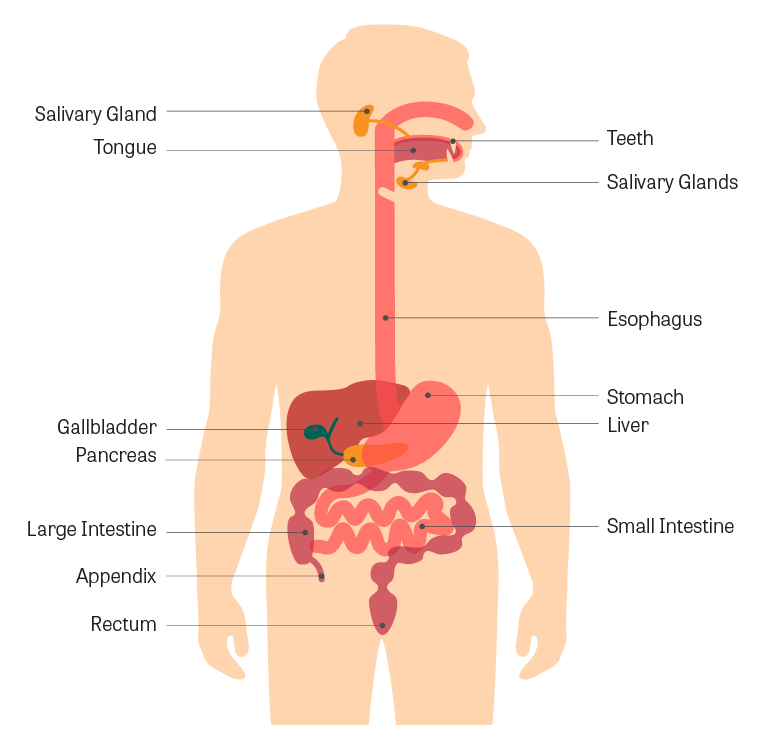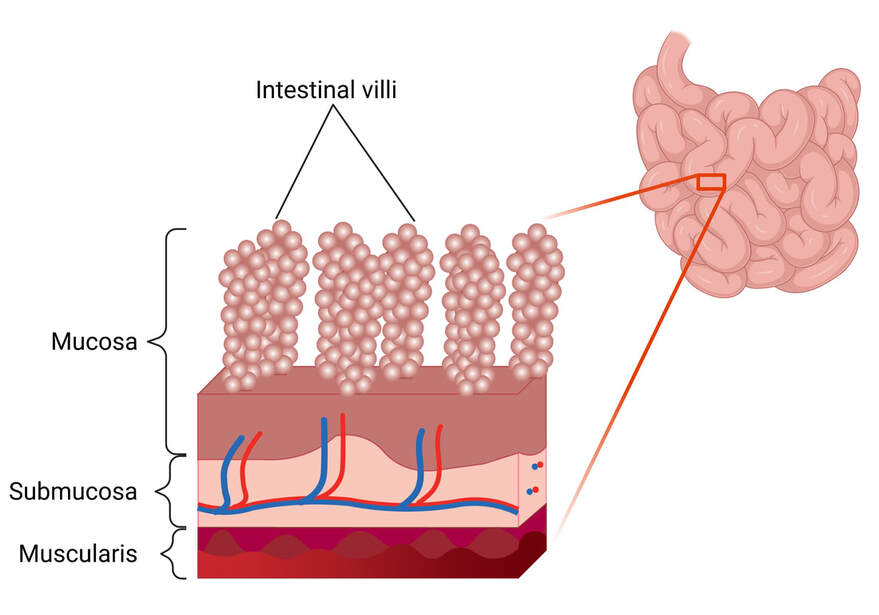Gastrointestinal Tract
The gastrointestinal (GI) tract can be viewed as a tube going through the body (Figure 1). Its contents are considered exterior to the body until absorbed. Salivary glands, liver, and the pancreas are considered accessory glands of the GI tract as they have ducts entering the GI tract and secrete enzymes and other substances. For foreign substances to enter the body, they must pass through the gastrointestinal mucosa, crossing several membranes before entering the bloodstream.
Substances must be absorbed from the gastrointestinal tract in order to exert a toxic effect throughout the whole body, although local gastrointestinal damage may occur from direct exposures to toxicants. Absorption can occur at any place along the entire gastrointestinal tract. However, the degree of absorption depends on the site.
Three main factors affect absorption within the various sites of the gastrointestinal tract:
Substances must be absorbed from the gastrointestinal tract in order to exert a toxic effect throughout the whole body, although local gastrointestinal damage may occur from direct exposures to toxicants. Absorption can occur at any place along the entire gastrointestinal tract. However, the degree of absorption depends on the site.
Three main factors affect absorption within the various sites of the gastrointestinal tract:
- Type of cells at the specific site.
- Period of time that the substance remains at the site.
- pH of stomach or intestinal contents at the site.
Figure 1. Anatomy of gastrointestinal tract
(Image Source: adapted from iStock Photos, ©)
(Image Source: adapted from iStock Photos, ©)
Mouth and Esophagus
Under normal conditions, xenobiotics are poorly absorbed within the mouth and esophagus, due mainly to the very short time that a substance resides within these portions of the gastrointestinal tract. There are some notable exceptions. For example:
Stomach
The stomach, with its high acidity (pH 1-3), is a significant site for the absorption of weak organic acids, which exist in a diffusible, nonionized and lipid-soluble form. In contrast, weak bases will be highly ionized and therefore poorly absorbed. The acidic stomach may chemically break down some substances. For this reason, those substances must be administered in gelatin capsules or coated tablets, which can pass through the stomach into the intestine before they dissolve and release their contents.
Another determinant that affects the amount of a substance that will be absorbed in the stomach is the presence of food in the stomach. Food ingested at the same time as the xenobiotic may result in a considerable difference in absorption of the xenobiotic.
Intestine
The greatest absorption of chemicals, as with nutrients, takes place in the intestine, particularly in the small intestine. The intestine has a large surface area consisting of outward projections of the thin (one-cell thick) mucosa into the lumen of the intestine (the villi) (Figure 2). This large surface area facilitates diffusion of substances across the cell membranes of the intestinal mucosa.
Since the pH is near neutral (pH 5-8), both weak bases and weak acids are nonionized and are usually readily absorbed by passive diffusion. Lipid soluble, small molecules effectively enter the body from the intestine by passive diffusion.
Under normal conditions, xenobiotics are poorly absorbed within the mouth and esophagus, due mainly to the very short time that a substance resides within these portions of the gastrointestinal tract. There are some notable exceptions. For example:
- Nicotine readily penetrates the mouth mucosa.
- Nitroglycerin is placed under the tongue (sublingual) for immediate absorption and treatment of heart conditions.
Stomach
The stomach, with its high acidity (pH 1-3), is a significant site for the absorption of weak organic acids, which exist in a diffusible, nonionized and lipid-soluble form. In contrast, weak bases will be highly ionized and therefore poorly absorbed. The acidic stomach may chemically break down some substances. For this reason, those substances must be administered in gelatin capsules or coated tablets, which can pass through the stomach into the intestine before they dissolve and release their contents.
Another determinant that affects the amount of a substance that will be absorbed in the stomach is the presence of food in the stomach. Food ingested at the same time as the xenobiotic may result in a considerable difference in absorption of the xenobiotic.
Intestine
The greatest absorption of chemicals, as with nutrients, takes place in the intestine, particularly in the small intestine. The intestine has a large surface area consisting of outward projections of the thin (one-cell thick) mucosa into the lumen of the intestine (the villi) (Figure 2). This large surface area facilitates diffusion of substances across the cell membranes of the intestinal mucosa.
Since the pH is near neutral (pH 5-8), both weak bases and weak acids are nonionized and are usually readily absorbed by passive diffusion. Lipid soluble, small molecules effectively enter the body from the intestine by passive diffusion.
Figure 2. Anatomy of structures in small intestine used for absorption
(Image Source: iStock Photos, ©)
(Image Source: iStock Photos, ©)
In addition to passive diffusion, facilitated and active transport mechanisms move certain substances across the intestinal cells into the body, including essential nutrients such as glucose, amino acids, and calcium. These mechanisms also transport strong acids, strong bases, large molecules, and metals, including some important toxins.
Intestinal microflora and gastrointestinal enzymes can affect the toxicity of ingested substances. Some ingested substances may be only poorly absorbed but they may be biotransformed within the gastrointestinal tract. In some cases, their biotransformed products may be absorbed and be more toxic than the ingested substance.
Colon and Rectum
Very little absorption takes place in the colon and rectum. As a rule, if a xenobiotic has not been absorbed after passing through the stomach or small intestine, very little further absorption will occur. However, there are some exceptions, as some medicines may be administered as rectal suppositories with significant absorption.
- For example, lead, thallium, and paraquat (herbicide) are toxins that active transport systems move across the intestinal wall.
Intestinal microflora and gastrointestinal enzymes can affect the toxicity of ingested substances. Some ingested substances may be only poorly absorbed but they may be biotransformed within the gastrointestinal tract. In some cases, their biotransformed products may be absorbed and be more toxic than the ingested substance.
- An important example is the formation of carcinogenic nitrosamines from non-carcinogenic amines by intestinal flora.
Colon and Rectum
Very little absorption takes place in the colon and rectum. As a rule, if a xenobiotic has not been absorbed after passing through the stomach or small intestine, very little further absorption will occur. However, there are some exceptions, as some medicines may be administered as rectal suppositories with significant absorption.
- An example is Anusol (hydrocortisone preparation) used for the treatment of local inflammation which is partially absorbed (about 25%).
Knowledge Check (Solutions on next page)
1) The most important factor that determines whether a substance will be absorbed within the stomach is the:
a) Physical form as a solid or liquid
b) Molecular size
c) pH
2) The primary routes for absorption of environmental agents are:
a) Gastrointestinal tract, respiratory tract, and skin
b) Conjunctival exposures and skin wounds
3) The site of the gastrointestinal tract where most absorption takes place is:
a) Stomach
b) Small intestine
c) Colon and rectum
1) The most important factor that determines whether a substance will be absorbed within the stomach is the:
a) Physical form as a solid or liquid
b) Molecular size
c) pH
2) The primary routes for absorption of environmental agents are:
a) Gastrointestinal tract, respiratory tract, and skin
b) Conjunctival exposures and skin wounds
3) The site of the gastrointestinal tract where most absorption takes place is:
a) Stomach
b) Small intestine
c) Colon and rectum



